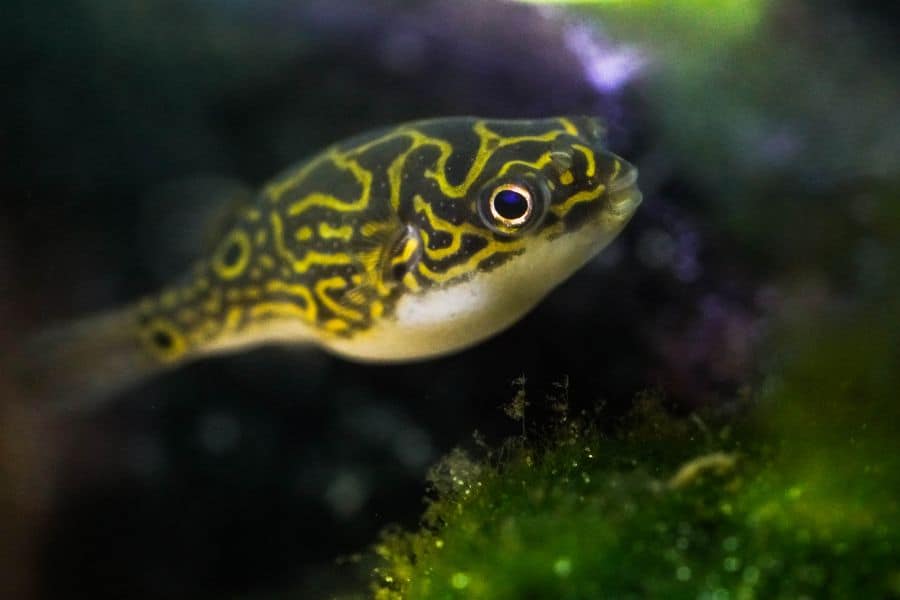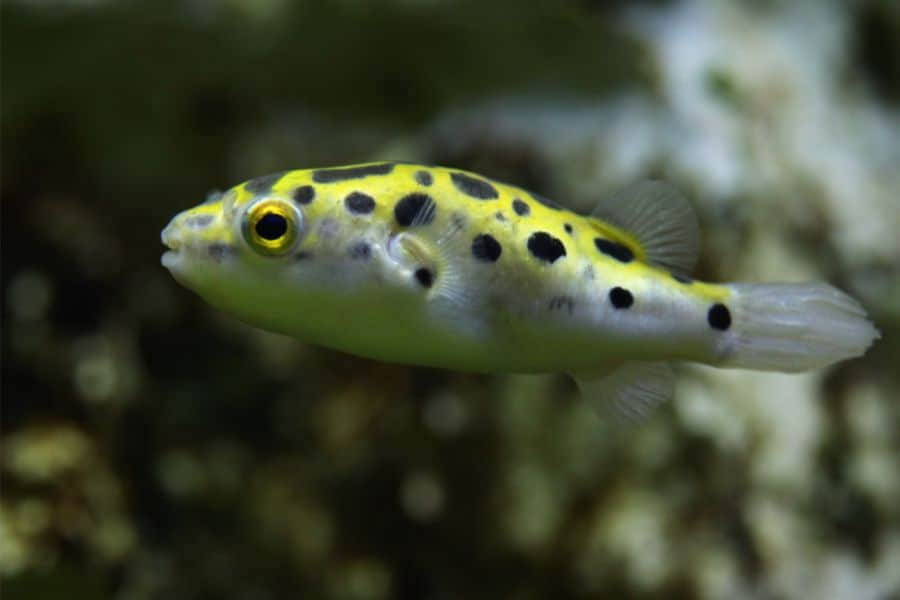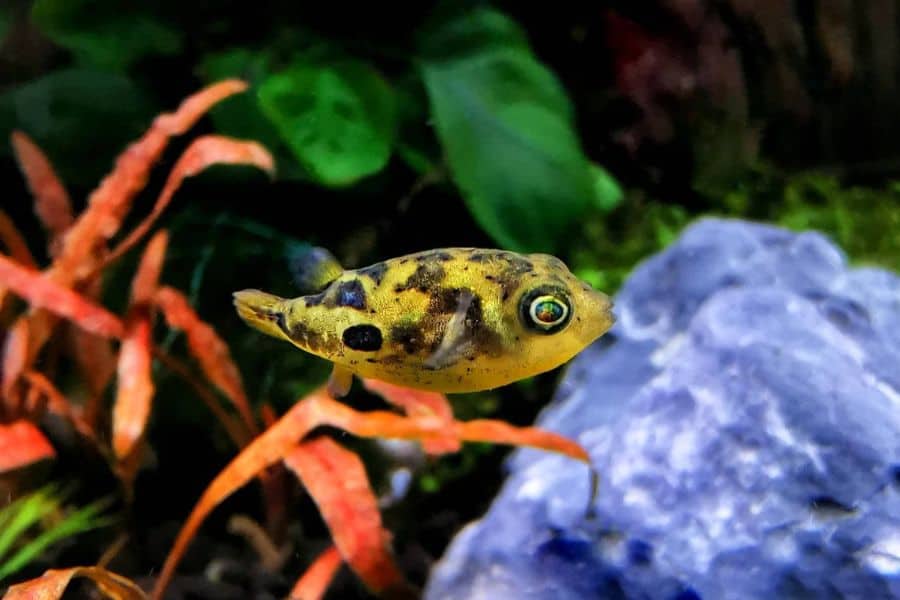If there’s one thing that hobbyists look for in a fish, it would be personality. There’s just something about seeing a touch of intelligence in how your fish swim and interact with the world around them that’s incredibly rewarding to witness.
And if you’re looking for personality, the puffer fish has it in spades. They can look cute and unassuming, but don’t let them fool you – they have boundless curiosity and incredible individuality that will make it feel like you’re taking care of a tiny fish-shaped human instead of an animal.
But with a great personality comes great responsibility. Puffers are not the most beginner-friendly fish, and they have specific care needs you need to know about to ensure they are happy and healthy.
That’s why in this article, we’re going through the top 10 most popular freshwater puffers and their most crucial care requirements!
Most Popular Freshwater Puffer Fish
1. Green Spotted Puffer
- Scientific Name: Tetraodon nigroviridis
- Care Difficulty: Intermediate
- Adult Size: 6 inches
- Ideal Minimum Tank Size: 30 gallons
- Water Type: Freshwater to Brackish
- Minimum Number: 1
- Temperament: Semi-aggressive
- Heater: No
Arguably one of the most beautiful-looking puffer species in the hobby, the green spotted puffer has captivated aquarists around the world with its exquisite patterns. They’re very intelligent and have even been known to recognize their owners when they approach the tank.
As their name suggests, they have a green body with psychedelic black or dark blue spots. Each puffer has unique markings, so you won’t find the exact same pattern twice. They can grow up to 6″ in length.
When it comes to care, the green spotted puffer isn’t for the faint of heart. They’re active swimmers that need a big tank to swim around in. They’re semi-aggressive and can hold their own against other fish, so ensure that you don’t put them with anything too small.
Depending on their personality, this puffer species can be housed in a community tank — just be ready to relocate them if they turn out to be aggressive. Also, it’s worth noting that adult green spotted puffers prefer brackish water, although juveniles can survive in freshwater.
2. Pea Puffer
- Scientific Name: Carinotetraodon travancoricus
- Care Difficulty: Advanced
- Adult Size: 1 inch
- Ideal Minimum Tank Size: 5 gallons
- Water Type: Freshwater
- Minimum Number: 1 male, 2+ females
- Temperament: Aggressive
- Heater: No
The Pea Puffer, also known as the Dwarf Puffer, is a captivating freshwater puffer species that’s extremely popular because of its small size and big personality.
Like the green spotted puffer, they also have a leopard-like pattern on their back, although they won’t look like the clearly-defined spots. Instead, pea puffers have spots ranging from dots to blobs, varying colors like green, yellow, and black.
Their main draw is their cute size. Unlike other puffer species that can grow to half a foot, pea puffers only grow up to an inch, making them exceptionally well-suited for smaller tanks. They’re also very social regarding females of their species but are incredibly aggressive towards other males.
Keeping them in a community tank can be a hit or miss, but if you decide to, make sure there are plenty of space and cover, and you keep them with fast swimming fishes.
Pea puffers are also recognized for their specialized dietary needs. They are strict carnivores, making them challenging for beginners who are more accustomed to feeding standard fish flakes.
3. Eyespot Puffer
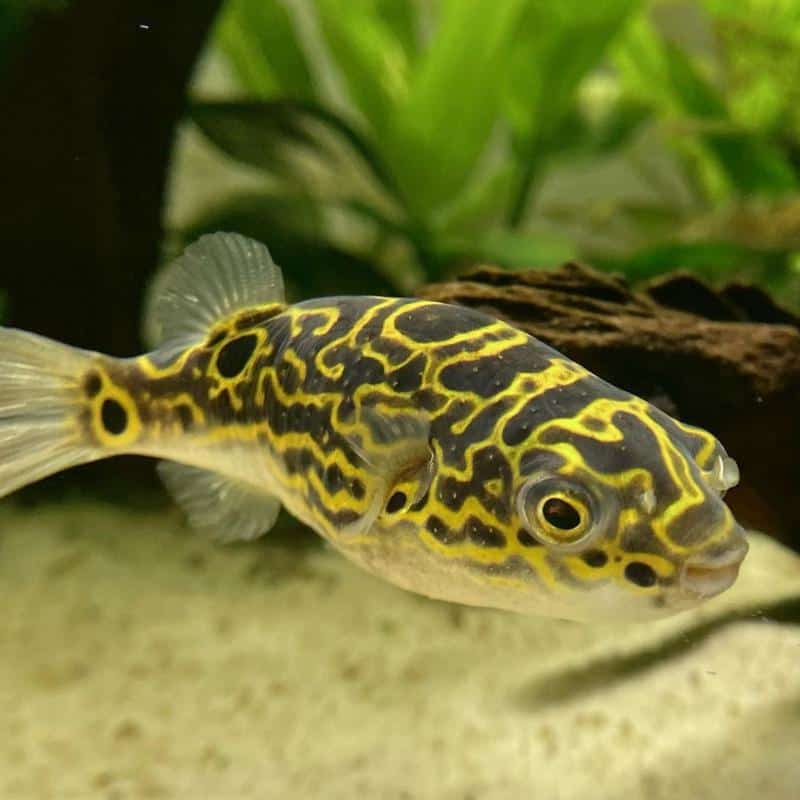
- Scientific Name: Dichotomyctere ocellatus
- Care Difficulty: Advanced
- Adult Size:5 inches
- Ideal Minimum Tank Size: 30 gallons
- Water Type: Freshwater or Brackish
- Minimum Number: 1
- Temperament: Aggressive
- Heater: No
Also called the “Figure 8” puffer because of its mind-bending patterns, the eyespot puffer is sure to catch your eye. Aside from their intricate patterns, this unique fish got its name from their body’s striking “eyespot” patterns.
While their distinctive appearance and rare beauty attract enthusiasts, their exacting care requirements make them a less suitable choice for newbies to the hobby.
This challenging puffer is often favored by advanced hobbyists who appreciate the challenge of catering to its specific needs. Their care demands include soft water conditions and precise feeding schedules, as they require a varied diet of small crustaceans and insect larvae.
They’re also very active swimmers, so they need a ton of space even though they’re just about 3 inches big. Plus, they can be quite aggressive to other swimmers, to boot.
Despite their challenging upkeep, the eyespot puffer can be a stunning and rewarding species for those willing to step up to the plate.
4. Imitator Puffer
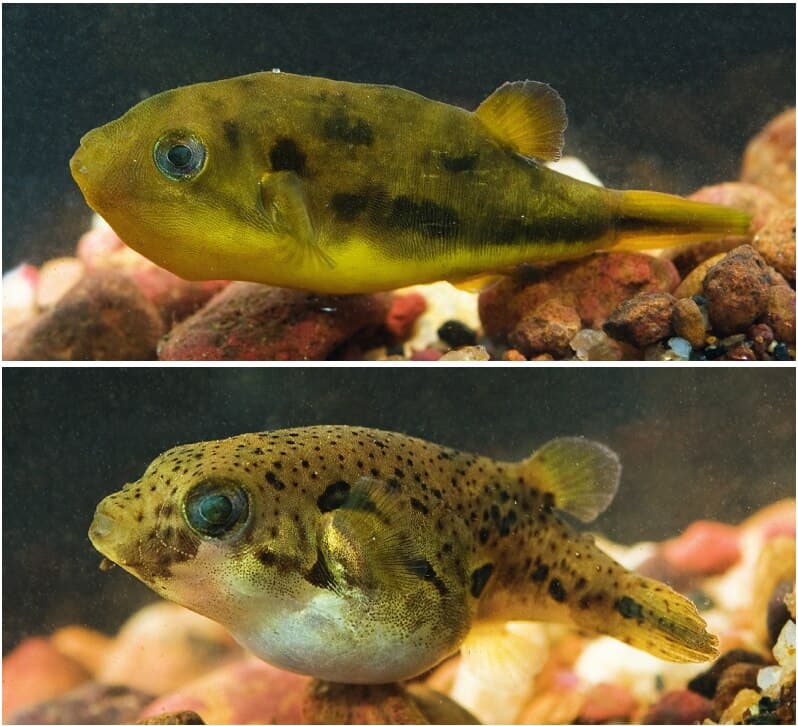
- Scientific Name: Carinotetradon imitator
- Care Difficulty: Advanced
- Adult Size: 1 inch
- Ideal Minimum Tank Size: 10 gallons
- Water Type: Soft freshwater water
- Minimum Number: 1 male, 2+ females
- Temperament: Aggressive
- Heater: Yes (76 – 82F)
The imitator puffer is a close relative of the pea puffer, known to look quite identical to each other. As if that isn’t confusing enough, pea puffers are also known as Malabar puffers, while imitator puffers are known as dwarf Malabar puffers — and yet both of them are roughly the same size.
Worse, fish exporters often don’t distinguish between them, resulting in mislabelling and cross-species breeding.
Additionally, these two species have the same general requirements. This means they also need space, can be aggressive toward other species, and have specific dietary needs since they’re strict carnivores.
However, this species somewhat distinguishes itself from dwarf puffers with their coloration. They have fewer spots and patterns and take on a more yellow color compared to their close cousins. Imitator puffers also aren’t as common in aquarium stores as pea puffers.
5. MBU Puffer (Giant Puffer)
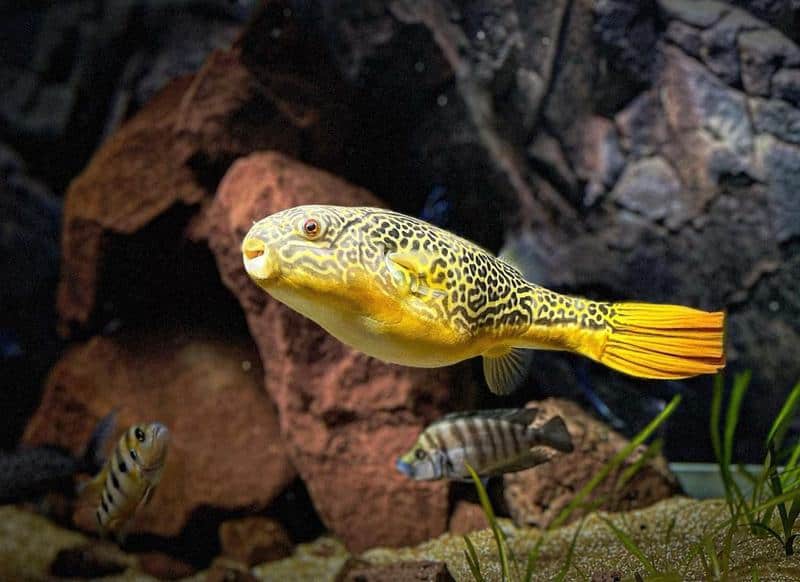
- Scientific Name: Tetraodon mbu
- Care Difficulty: Advanced
- Adult Size: 30 inches
- Ideal Minimum Tank Size: 500 gallons
- Water Type: Freshwater
- Minimum Number: 1
- Temperament: Semi-peaceful
- Heater: Yes (76 – 82F)
The MBU Puffer is an awe-inspiring freshwater giant known for its substantial size and distinctive appearance.
Also known as Giant puffer, this species’ sheer size and unique coloration have captivated enthusiasts since they were first introduced to the hobby. Its large body, often adorned with psychedelic patterns of green, silver, and black, demands attention from observers.
MBU puffers are also some of the rarer peaceful puffer species, as they’re known not to mind other fish. That is, as long as they’re not stealing its food.
More than that, they’ve also been known to recognize and interact with their owners. However, despite their interesting appearance and appealing personalities, they’re best left to the hobbyists with experience and resources to properly take care of them.
The first challenge that potential fishkeepers will have to overcome is the size. True to its name, giant puffers reach up to 30 inches, meaning you’ll need 500 gallons of water at the minimum. They’re also very expensive to acquire and feed, as well as virtually impossible to breed.
Still, if you have the guts and the money, these giants will surely be a showstopper in your home aquarium.
6. Congo Puffer
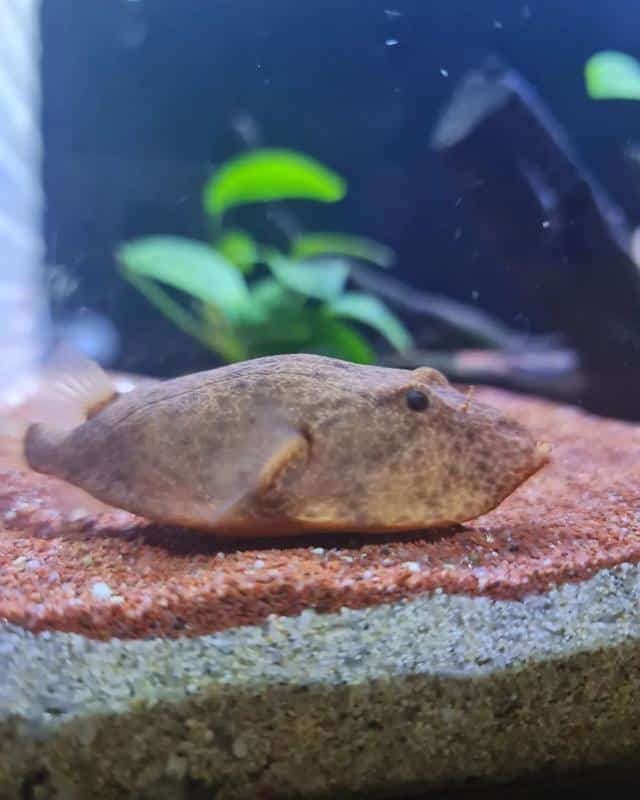
- Scientific Name: Tetraodon miurus
- Care Difficulty: Advanced
- Adult Size: 6 inches
- Ideal Minimum Tank Size: 20 gallons
- Water Type: Freshwater
- Minimum Number: 1
- Temperament: Predator
- Heater: Yes
The Congo Puffer is a fascinating hunter that is best kept alone, as it will prey on anything that can fit in its mouth.
You would be hard-pressed to find anything as mean as this puffer species. While the others may be aggressive towards males of their species or can nip the fins of other fish, this one will downright hunt them.
But that’s just one of its many allures. It’s also a fascinating ambush predator that prefers sand and other soft substrate — for the sole purpose of hiding while waiting for unsuspecting critters to come by.
They show no mercy whenever a creature gets into their orbit and will immediately pounce on them. They’ll eat smaller fishes that they can put into their mouths right up, but they’re also more than willing to take a bite out of larger ones that they can’t eat in one go.
Beyond their exciting hunting practices, they also have incredible looks, making them a centerpiece for any tank.
7. Spotted Congo Puffer
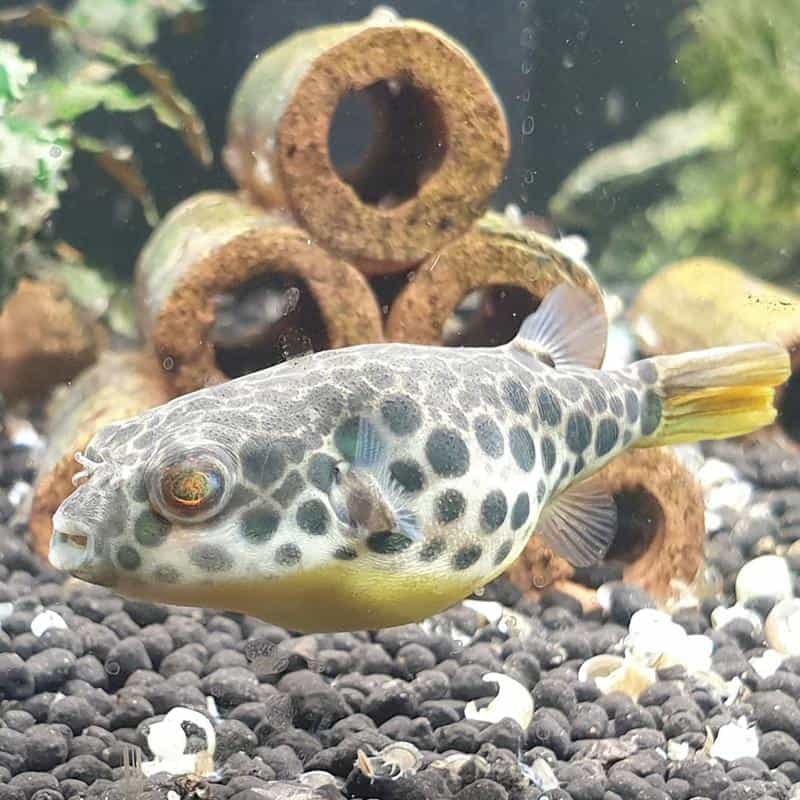
- Scientific Name: Tetraodon schoutedeni
- Care Difficulty: Intermediate
- Adult Size: 4 inches
- Ideal Minimum Tank Size: 30 gallons
- Water Type: Freshwater
- Minimum Number: 6
- Temperament: Semi-Aggressive
- Heater: Yes (78-81F)
Although they share similar name, the spotted congo puffer is a different species entirely to the congo puffer. And don’t worry, this one isn’t as aggressive and as challenging to maintain.
The spotted congo puffer is a beautiful small puffer species that can grow to a maximum of 4 inches in length, with highly social personalities. Still, they can show some aggression here and there, so they’re not for beginner community tanks either.
Like many puffers, they thrive on a diet of snails, worms, and other insects, and keeping up with the dietary requirements of 6 ravenous spotted congo puffers can be a challenge for some aquarists.
More than that, they also require stringent water parameters and specific tank requirements. They need their tank to be a lot like their habitat in the wild: soft lighting, plenty of hardy plants that will endure their leaf-biting tendencies, hard cover like driftwood, and a soft sandy substrate to feel at ease.
These might seem like a lot, but those who manage to cater to their every need will be rewarded by a fascinating and intelligent group of beautiful puffer fish.
8. Avocado Puffer
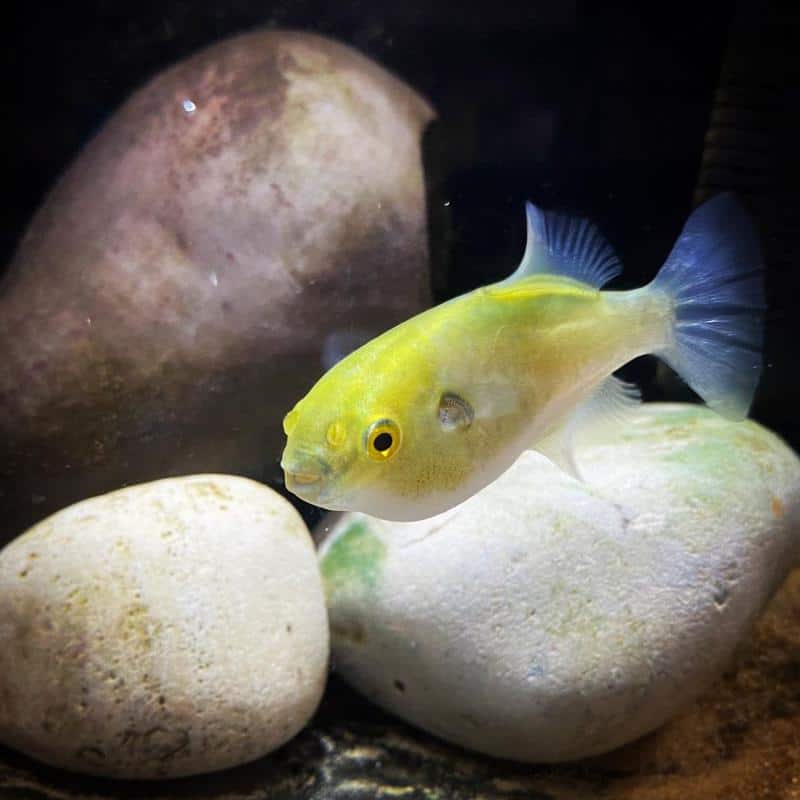
- Scientific Name: Auriglobus silus
- Care Difficulty: Advance
- Adult Size: 4 inches
- Ideal Minimum Tank Size: 30 gallons
- Water Type: Freshwater
- Minimum Number: 1
- Temperament: Aggressive
- Heater: Yes (74 – 80°F)
The Avocado Puffer, also known as the golden or bronze puffer, boasts a captivating appearance marked by a stunning golden hue that glows under the light.
With their spotlight-worthy appearance and interesting behavior, you’ll think they deserve their own tank. And actually, that’s a pretty good idea, because this fish can be incredibly aggressive to other fishes, even to their own kind.
A voracious hunter with an omnivore’s diet, Avocado puffers love eating insects, seeds, and shrimps. But they also like eating other fishes, especially those they can fit in their mouth.
Aside from this aggression, they can also be hard to care for due to their sensitivity to water changes. They can easily fall ill in less-than-perfect conditions.
Regardless of all that, though, these puffers still have plenty of dedicated fans. They’re quite rare, so interested fishkeepers can expect to pay a premium for this golden fish. If you have the time, energy, and resources to cater to their needs, you definitely won’t regret it.
9. Fahaka Puffer
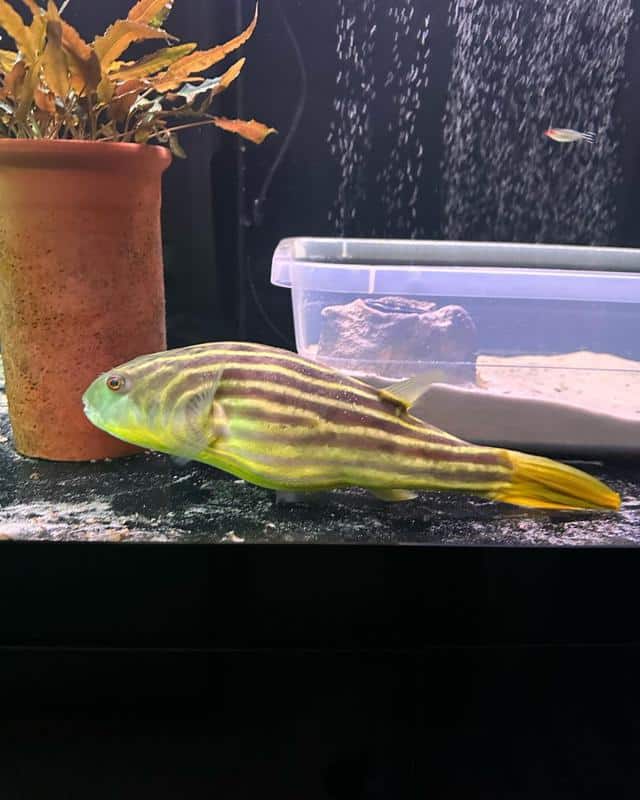
- Scientific Name: Tetraodon lineatus
- Care Difficulty: Advanced
- Adult Size: 17 inches
- Ideal Minimum Tank Size: 100 gallons
- Water Type: Freshwater
- Minimum Number: 1
- Temperament: Predatory
- Heater: No
The Fahaka Puffer is famous for its intricate markings and engaging behavior. This fish displays a mix of green, yellow, and black lines that runs from its head to its tail, giving it a strange-lined appearance.
Also known as the Nile puffer, this fish is prized for its appearance but feared for its predatory nature.
They can grow large, up to 17 inches long, and can easily terrorize any fish it encounters. Because of this, they need large habitats and are best kept with fast-swimming, fast-breeding species that they won’t be able to devour.
Nevertheless, those matching their size and dietary requirements will find a cool-looking, very intelligent “wet pet” that will even interact and play with its owners.
10. Amazon Puffer
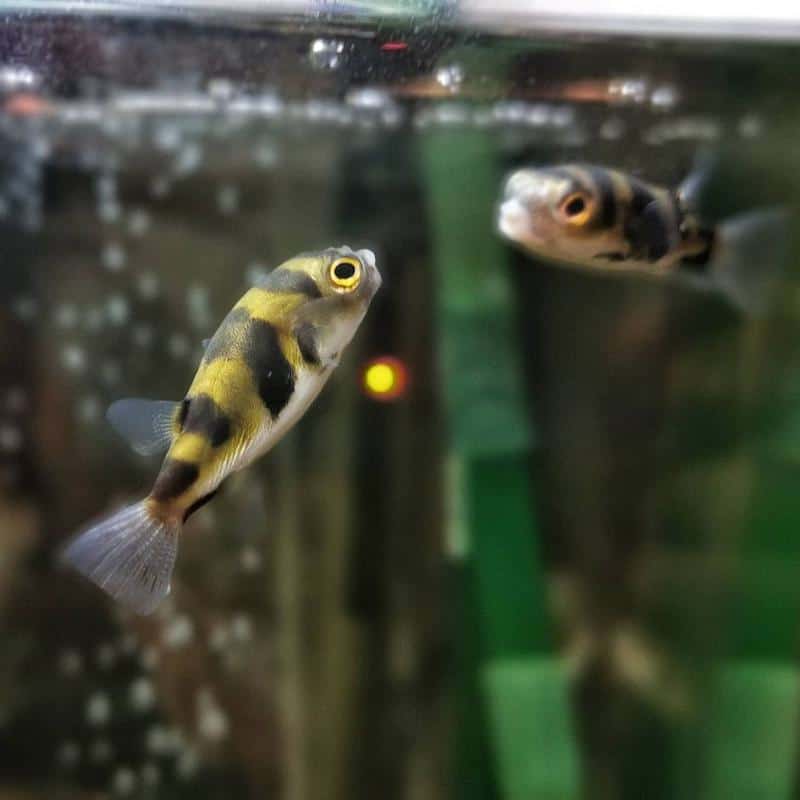
- Scientific Name: Colomesus asellus
- Care Difficulty: Intermediate
- Adult Size: 4 inches
- Ideal Minimum Tank Size: 30 gallons
- Water Type: Freshwater
- Minimum Number: 6
- Temperament: Semi aggressive
- Heater: Yes (72-82°F)
Prized for its peaceful temperament, the Amazon puffer fish is considered by some to be the top-tier community aquarium puffer fish because of their peaceful disposition. They’re well-loved by many aquarists, both beginner and expert alike.
They’re unlikely to fight or eat other fish in the aquarium, although they can get into squabbles amongst themselves. It’s best to keep them in a group of six or more to reduce their aggression.
These fish have a typical puffer shape and appearance, but they differ in their patterns. Rather than well-defined blobs, dots, or lines, Amazon puffers have five dark bands around their body, with blurred edges that blend into patches of color throughout.
While they’re popular because of how peaceful they are, it’s important to remember that, as a rule, puffer fish will be incredibly individualist. That’s what made them popular in the first place. As such, some Amazon puffers are likely to be more aggressive than others.
Nevertheless, if you want an interesting puffer you can house with other fish, the Amazon puffer should be at the top of your list.
Read More:
FAQs
Are Puffer Fish Beginner Friendly?
No, puffer fish are not suitable for complete beginners. Even the most peaceful puffer fish still has significant care requirements, such as diet, water parameters, and space needs. Unless they prefer far in advance, beginners are advised to choose hardier and less sensitive species.
Are Puffer Fish Poisonous?
Yes, as a general rule, most puffer fish are poisonous. To protect themselves against predators, they excrete a slime covering around their skin that can poison humans and other animals if ingested. There have even been cases of humans being poisoned simply by touching them.
What Do Puffer Fish Eat in The Aquarium?
Most pufferfish are true carnivores, which means they only eat other animals. Preferences can vary between species, but most puffer fish eat snails, worms, and insects. Some puffer fish, like the Congo puffer fish, are also known to hunt other fish.
Final Thoughts
Pufferfish can be incredibly entertaining and satisfying to keep, but they’re far from the perfect beginner fish. Keeping any puffer fish requires plenty of preparation and attentive care, so it’s best to know everything you can about the species you want to keep.
This article discussed the top 10 most popular freshwater puffer fish and the most important need-to-knows to help you in your journey. With this guide in your arsenal, you’re now ready to jump into the world of puffer fish!
